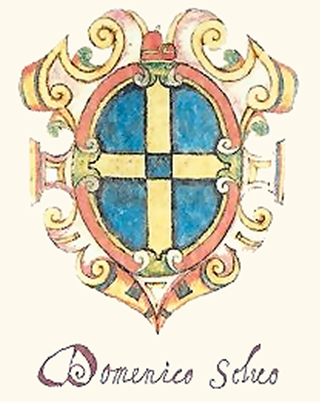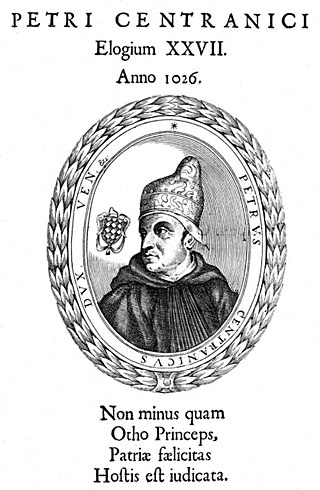Related Research Articles

Pietro II Orseolo (961−1009) was the Doge of Venice from 991 to 1009, and a member of the House of Orseolo. He began the period of eastern expansion of Venice that lasted for the better part of 500 years. He secured his influence in the Dalmatian Romanized settlements from the Croats and Narentines, freed Venetia from a 50-year-old taxation to the latter, and started Venetia's expansions by conquering the islands of Lastovo (Lagosta) and Korčula (Curzola) and acquiring Dubrovnik (Ragusa).

Gian Francesco Malipiero was an Italian composer, musicologist, music teacher and editor.

The House of Orseolo was a powerful Venetian noble family descended from Orso Ipato and his son Teodato Ipato, the first Doges of Venice. Four members of the Orseolo family became Doges, Commander of the Venetian fleet, and King of Hungary. They reconstructed St Mark's Basilica and the Doge's Palace after the revolution.

The naval Battle of Zonchio took place on four separate days: 12, 20, 22, and 25 August 1499. It was a part of the Ottoman–Venetian War of 1499–1503.

Pietro I Orseolo OSBCam, also named Peter Urseulus, (928–987) was the Doge of Venice from 976 until 978. He abdicated his office and left in the middle of the night to become a monk. He later entered the order of the Camaldolese Hermits of Mount Corona. He is venerated as a saint in the Catholic Church. In 1733 the Venetian librarian Giuseppe Bettinelli published an edition of a biography written by the Friar Fulgenzio Manfredi in 1606.

Domenico Selvo was the 31st Doge of Venice, serving from 1071 to 1084. During his reign as Doge, his domestic policies, the alliances that he forged, and the battles that the Venetian military won and lost laid the foundations for much of the subsequent foreign and domestic policy of the Republic of Venice. He avoided confrontations with the Byzantine Empire, the Holy Roman Empire, and the Roman Catholic Church at a time in European history when conflict threatened to upset the balance of power. At the same time, he forged new agreements with the major nations that would set up a long period of prosperity for the Republic of Venice. Through his military alliance with the Byzantine Empire, Emperor Alexios I Komnenos awarded Venice economic favors with the declaration of a golden bull that would allow for the development of the republic's international trade over the next few centuries.

Pietro Barbolano was the 28th Doge of Venice. Reportedly a descendant of the legendary Eraclea, he was elected by the assembly of the nobles after the deposition of his predecessor, Otto Orseolo. The dates of his birth and death are unknown.

Otto Orseolo was the Doge of Venice from 1008 to 1026. He was the third son of Doge Pietro II of the House of Orseolo, and Maria Candiano, whom he succeeded at the age of sixteen, becoming the youngest doge in Venetian history.
Vitale Candiano was the 24th doge of the Republic of Venice.

The Conservatorio di Musica Benedetto Marcello di Venezia, also known as the Venice Conservatory, is a conservatory in Venice, Italy, named after composer Benedetto Marcello and established in 1876.

The House of Loredan is a Venetian noble family of supposed ancient Roman origin, which has played a significant role in shaping the history of the entire Mediterranean. A political dynasty, the family has throughout the centuries produced a number of famous personalities: doges, statesmen, magnates, financiers, diplomats, procurators, military commanders, naval captains, church dignitaries, writers, and lawyers.
Riccardo Malipiero Jr. was an Italian composer, pianist, critic, and music educator. He was awarded the gold medal by the city of Milan in 1977 and by the city of Varese in 1984.
This article presents a detailed timeline of the history of the Republic of Venice from its legendary foundation to its collapse under the efforts of Napoleon.

The Coinage of the Republic of Venice include the coins produced by the Republic of Venice from the late 12th century to 1866. After this date, coins were still produced in Venice.

The Doge on the Bucintoro near the Riva di Sant'Elena is an oil painting on canvas by the Venetian painter Francesco Guardi. It was painted between 1775 and 1780, and is now in the Louvre in Paris.
Venier is a Venetian surname, derived from the Medieval name Venerius. Notable people with the surname include:
Felicia Malipiero was the Dogaressa of Venice by marriage to the Doge Pietro I Orseolo and mother of doge Pietro II Orseolo.
The siege of Lastovo in 1000 was part of the campaign of Doge Pietro II Orseolo in southern Croatia and its bloodiest armed conflict between the citizens of Lastovo island and the army of Venice. The siege resulted in a Venetian victory and Lastovo was annexed into the Venetian republic.
This is an alphabetical index of people, places, things, and concepts related to or originating from the Republic of Venice. Feel free to add more, and create missing pages.
Loredan is a Venetian surname. The House of Loredan is an aristocratic Venetian family that included various doges of the Republic of Venice, and the surname is almost exclusively associated with the family. The surname most likely originated from the toponym Loreo, which itself originated from its Latin name Lauretum, meaning laurel. Another theory of the origin of the surname, though most likely legendary, is that it comes from the Latin epithet Laureati, given to ancestors of the Loredan family due to their historical glory in ancient Rome and the many victories they achieved in battles. The surname is spelled Loredano or Loredan in Italian, Lauredano or Lauredanus in Latin, and Lorentano (Λορεντάνο) in Greek, though it is also historically found as Lordas (Λορδᾶς) and Lordano (Λορδάνο). The feminine name Loredana, common in Italy and Romania, was likely inspired by the surname.
References
- ↑ "MALIPIERO". palazzomalipiero.it.